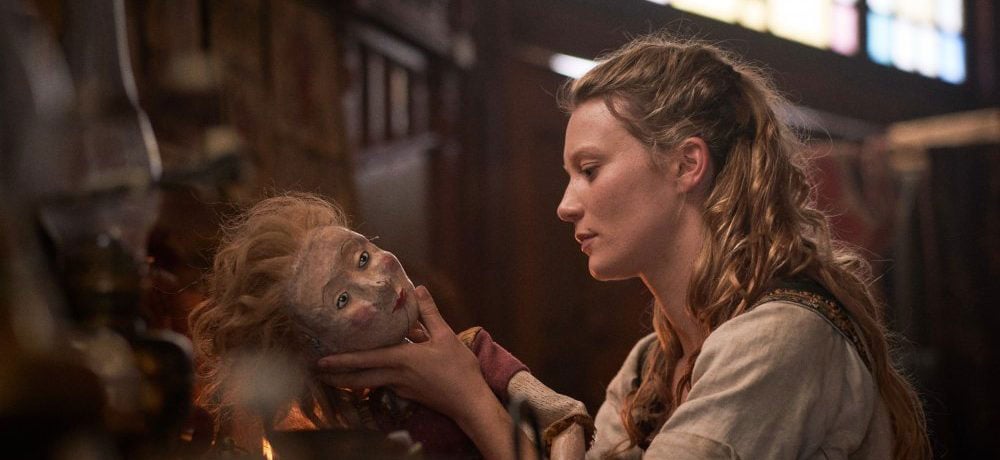


Whenever Disney announces a new live-action film, there’s a collective: “Ah, shit. Here we go again.” It shows a lack of creativity in taking their animated works and making them “real”. Judy & Punch falls under the category of taking an established story from one medium and bringing it to life in another, but it’s unique in the way it does so. It takes the traditional trappings and characters of the British Punch and Judy puppet show and plays them out in live-action with magical whimsy in this black comedy about a puppeteering duo. Their performances aren’t simply a dance of marionette strings, but art imitating life in very punchy ways, and with themes that have hard-hitting relevancy as writer-director, Mirrah Foulkes, reimagines an old, misogynistic tale into what she calls, “a feminine inversion of the traditional hero’s journey.”
Punch and Judy, despite its roots in Italian commedia dell’arte, is most associated with British culture. It’s a traditional puppet show featuring the characters Mr. Punch and his wife, Judy. Punch and Judy made its first appearance in England in 1662 during the Restoration Period of Charles II, a period where art and theatre thrived. The show was originally made up of marionettes but was later changed to glove puppets to accommodate the physicality and violence of its characters (and because marionette productions were expensive). It’s a black comedy in its own right which the film sticks to, and they both carry the same dark tone. The puppet show’s premise is famous and its narrative beats have remained relatively the same over the centuries: Punch and Judy have a baby for which Punch is unable or unwilling to care for; the couple violently quarrel and fight; in defense of Judy’s abuse at the hands of Punch, a policeman comes to help; Punch goes on a murder spree and he eventually meets a final foe in the form of either a hangman, the devil, a crocodile, or a ghost. The narrative is the same in many respects, but also different in many others. While all the aforementioned foes fit into the film in various ways, the biggest difference is that, in the end, the final foe that Punch meets is Judy.
In a theatre draped in bold reds, we are introduced to Punch’s Puppet Play and its puppeteers, husband and wife duo, Punch (Damon Herriman) and Judy (Mia Wasikowska). Judy is the superior of the two in her talents on the strings (her name should have come first in the title all along). They live and perform in a town called Seaside that’s nowhere near the sea. They’re much admired by the townsfolk, but Punch, obsessed with fame, dreams of bigger and better things. The couple used to go on tour, but they were kicked out of every town for Punch’s boozing and temper. They had no choice but to return to the town where they first met and performed. A town with few shillings to offer. Punch is hoping scouts will come out to see their show and they’ll be whisked away to bigger theatres in bigger cities. But this ambition doesn’t outweigh the temptation of drink. Because he refuses to stay sober, the relationship between Judy and Punch crumbles through tragedy and violence. Punch’s true nature revealing itself – the human embodiment of the character is just as violent and domineering – as, after a row, he beats up his wife to near death. She’s found and healed by mysterious “heretics” living in the neighboring woods. She finds peace with these outsiders; free of patriarchy and the barbarism of a town whose only cure for boredom, only pleasure, comes in the form of hangings, burnings, and stonings. Judy seeks revenge, intending to cut Punch’s strings for good.
Judy & Punch is full of so many amusing scenarios of dark humor that leans into satire and provokes moments of both laughter and shock. And it’s one of those films where it’s best not to discuss any of them; to go in as blind as possible and be immersed in its chaos. With an eclectic cast of entertaining characters, led by Herriman, who gives one of the best performances of the year as the outrageous maniac at the film’s center, and Wasikowska who’s the film’s heart as the stoic Judy. It’s eye-catching in its atmosphere, costume design by Edie Kurzer, and set pieces, all fitting perfectly into the Gothic 17th-century British aesthetic despite actually being filmed in Australia. It’s a feast for the eyes, but also the ears with one of the most bewitching scores of the year. The music by François Tétaz is whimsical and mixes electric, rock, and classical beats. We also have to respect any film that uses Leonard Cohen’s “Who by Fire”.
Feminist revenge films are common and ones that continue to garner excitement despite many of them leaning into similarities. It’s a necessary narrative as it shows women who aren’t silenced and can fight back and win. Judy & Punch’s setting and premise make this narrative feel somewhat more unique than most, but despite much of the narrative being about Judy seeking revenge for the cruelties of her husband, the most important message (and most hard-hitting during our climate of civil rights protests) is that of embracing the other. The power of the outsider, whom those who show prejudice are nothing without. It’s a confrontation of the fear of difference in a “blinkered view of the world.” A world that would be a much better and happier place if we all came together.
Movie Score: 4/5